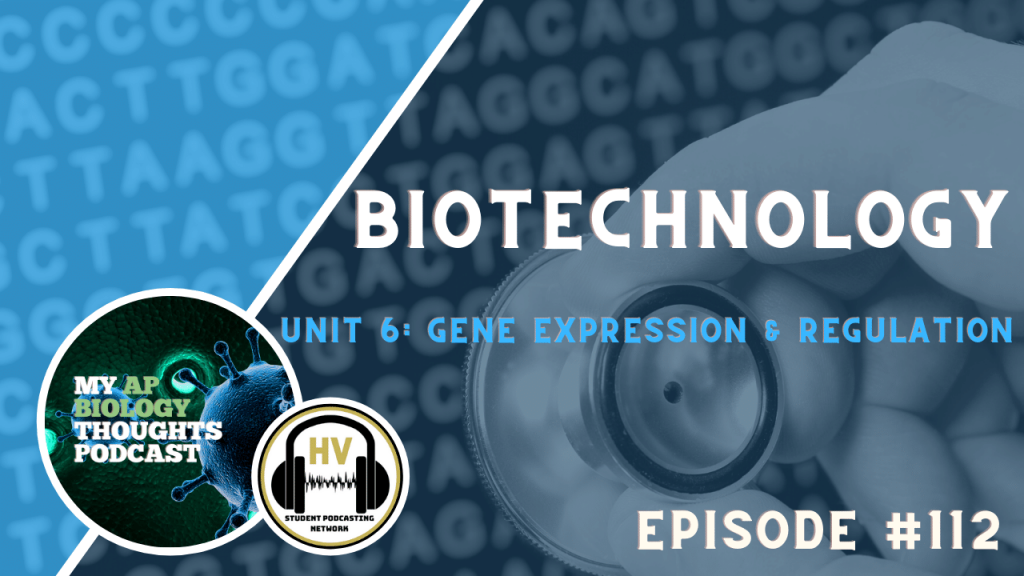Biotechnology

My AP Biology Thoughts
Unit 6 Gene Expression and Regulation
Welcome to My AP Biology Thoughts podcast, my name is Sid and I am your host for episode #112 called Unit 6 Gene Expression and Regulation: Biotechnology. Today we will be discussing how we use technology to study how the mechanisms of DNA and gene expression work.
Segment 1: Introduction to Biotechnology
The four main processes used in biotechnology that relate to this unit are bacteria transformation, PCR, electrophoresis, and DNA sequencing. Bacterial transformation makes multiple copies of a recombinant DNA molecule. PCR is used to produce millions of copies of a DNA sequence from an initial sample. Electrophoresis separates DNA and RNA molecules by their size and their electrical charge. DNA sequencing is used to determine the sequence of the bases in a DNA molecule.
Segment 2: More About Biotechnology
- First we’ll talk about bacterial transformation. The process of bacterial transformation starts with mixing the prepared bacteria with DNA. Then the bacteria are heat shocked. This allows them to take up a plasmid. The bacteria that take up the plasmid become resistant to antibiotics, so we place all of the bacteria on an antibiotic plate. The ones that survive are the ones that are known to have taken up the plasmid since they survived the antibiotic. The bacteria without the plasmid end up dying. The bacteria that survived end up being used to create a cluster of identical bacteria that also contain the plasmid. The colony containing the plasmid is grown and used to produce the plasmid or proteins.
- Another form of biotechnology is PCR. To begin, the main ingredients (taq polymerase, primers, template DNA, nucleotides, and cofactors) are all added in a tube. The first step of PCR is denaturation. In denaturation the reaction is heated so that the DNA strands separate and create single strands. The next step is annealing where the reaction is cooled so that the primers bind to the complementary sequence on the DNA strands. The third step is extension. In this step the temperature is raised again so that the taq polymerase starts at the primers and synthesizes new strands of DNA. This cycle repeats between 25-35 times which ends up creating millions of copies of the same DNA region.
- Electrophoresis is another form of important bio technology. In electrophoresis, DNA samples are placed into indentations at one end of a gel. THis gel gets an electric current applied to it. Since DNA fragments are negatively charged, they move towards the positive electrode. Because the DNA fragments have the same charge, the smaller fragments are able to move through the gel faster than the large ones. This allows the DNA to be separated by size. The gel is then stained with a DNA binding dye which makes the DNA fragments appear as bands so that they can be observed.
- The last thing we are going to talk about is DNA sequencing. In DNA sequencing, the DNA strand goes through bacterial transformation so that we can produce many copies of it in a plasmid. The DNA is then isolated and goes into a plate with other ingredients like the DNA bases, DNA polymerase, primers, and modified bases labeled with colored fluorescent tags called terminator bases. This mixture then goes through a process very similar to PCR. The difference is when polymerase adds the bases, it eventually adds a terminal base which makes it so that no more bases can be added to the strand of DNA. This then produces lots of fragments of DNA at different lengths. Then when we separate them by size through electrophoresis, we can figure out where the beginning of the sequence is. When the fragments are separated in the gel, a laser reads the terminator base of each strand which gives us the full sequence of bases
Segment 3: Connection to the Course
- It’s important for us to know how these different processes work because it helps us understand how we apply the things we know about gene expression and regulation. The knowledge of gene expression and regulation allows scientists to create processes like PCR, electrophoresis, bacterial transformation, and DNA sequencing. For example scientists use what they know about DNA replication in order to replicate DNA at an exponential rate in a lab through PCR. These different processes help us in scientific research and in medicine.
Thank you for listening to this episode of My AP Biology Thoughts. For more student-ran podcasts and digital content, make sure that you visit www.hvspn.com.
Music Credits:
- “Ice Flow” Kevin MacLeod (incompetech.com)
- Licensed under Creative Commons: By Attribution 4.0 License
- http://creativecommons.org/licenses/by/4.0/
Subscribe to our Podcast
Connect with us on Social Media
Twitter @thehvspn

